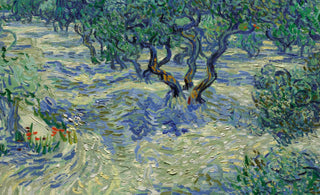
There is plenty to consider if you are thinking about investing in art - for example, what type of art you wish to buy - blue-chip art, old masters, or art from emerging artists.
Despite being polar opposites, blue-chip and red-chip art share many similarities. But what exactly is blue-chip art, and what is red-chip art? And more importantly, which is best to invest in? This is what we are going to be exploring in this blog.
Read on to learn more about red-chip art and blue-chip art, including the differences between the two. In this blog, we’ll also be discussing which is best to invest in, ensuring you make the right decision when investing in art.
What is Blue Chip Art?
Before we explore blue-chip vs red-chip art, let’s outline the basics of blue-chip art. Blue-chip art is created by blue-chip artists - leading names in the art industry. Some blue-chip artists could include Andy Warhol, Keith Haring, and street artist Banksy.
These artists all have several things in common - they create art that sells for high amounts of money at auctions and they have a history of creating pieces of art that increases in value. Blue-chip art often generates record-setting results at auctions, making blue-chip art in high demand and low supply.
This is the perfect combination for bidding wars among art collectors. You may be wondering where the term ‘blue chip’ comes from. The term is borrowed from poker - referring to blue poker chips.
You may come across white chips, red chips and blue chips in a game of poker, with blue chips holding the most value. The term was then used to describe high-quality stocks.
People began calling stocks from quality businesses that had a history of generating profit ‘blue-chip stocks’. Blue-chip stocks are considered an attractive investment option because they have a history of success; investors will invest in blue-chip stocks with confidence.
What is Red Chip Art?
Red-chip art is essentially the opposite of blue-chip art. Red-chip artists typically rise to fame relatively quickly, gaining an online following - whether it be on Instagram, TikTok or other social media platforms.
They will use these platforms to promote their own work, achieving vast commercial success. This means that many red-chip artists are younger, and are emerging into the art world at a rapid speed. However, much like blue-chip art, red-chip art sells for remarkable prices at auctions on the secondary market. There are roughly a billion active users on Instagram - and being an image-based social media platform, Instagram is a great place for emerging artists to showcase their work and gain an online following.
Red-chip art promotes a more democratic art market; essentially meaning that anybody can pave their own way to artistic success without having to ‘pay their dues’, so to speak. Social media can also be a great way for artists to make connections with others in the industry, whether it be art dealers or other prominent artists. It is also a great way to connect with potential buyers.
Through social media, anybody can step foot into the art world, regardless of age, gender, or economic background. Some red-chip artists may include Hilary Pecis, Issy Woord, and many more - artists with a huge following and online presence.
Blue Chip and Red Chip Art - The Key Differences Explained
Art is a great investment - not only is it tangible, but can act as a hedge against inflation and can preserve its value in times of economic uncertainty. In fact, people with blue-chip artwork in their art collection will withhold the pieces of the most value in order to protect their capital.
This means that when there is high demand, there is typically a scarcity of blue-chip art on the art market. Because collectors were unwilling to sell their blue-chip pieces during previous times of financial distress, a new investment grade emerged to fill the gap - red-chip art.
Blue-chip art refers to work by artists who have a solid history of creating art that either maintains its value or increases in value - whereas red-chip artists may not have an extensive background in the art world. Red-chip artists will skip the steps that blue-chip artists take to develop their reputation - they often skip art galleries and dealers, and instead, build their reputation through the internet.
Both types of artwork sell for staggering prices, but red-chip art is not traditional or predictable. Read on to learn more about investing in blue-chip and red-chip art.
Which is Best to Invest In - Blue or Red Chip Art?
Red-chip art is a great investment - providing low-price entry artworks that can generate solid returns if the artist were to quickly rise to fame. That being said, red-chip art carries more risk.
So, to answer the question of which is best to invest in, blue-chip art is a better investment if you’re looking for stability, but red-chip art is best if you’re looking for lower entry costs but a chance of attractive returns. More and more people are leaning towards red-chip art.
At Christie’s, Dana Schutz’s ‘Elevator’ sold for $6.5m - which exceeded the $6.1m single bid for a hand-painted ‘Campbell’s Soup Can’ from Andy Warhol. The Warhol piece sold for $7.4m back in 2014, marking a shift from blue-chip to red-chip. If you’re unsure whether to invest in blue-chip or red-chip art, we can help.
At Grove Gallery, we are home to an expert art advisory service. Our team of dedicated art advisors can help you not only understand but navigate the art market. We can help you to choose the best art to add to your collection, whether it be from red-chip artists or blue-chip artists.
On average, we can help you generate between 8% and 12% profit. If you wish to learn more about art investments, you can contact us at 020 8103 4905 or download our art investment guide here.






